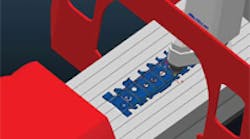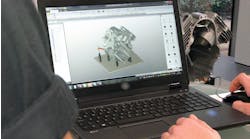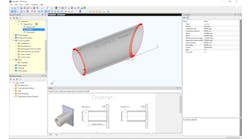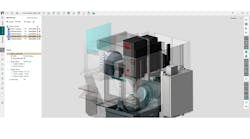Reported by Robert Brooks | Editor
Calculating formulae and information for toolpaths for larger and more complex parts is one of the advantages of parallel processing, and one of the advances of Delcam’s latest version CAM software, PowerMILL 10.
You may have heard this phrase: “parallel processing.” It comes from the world of psychology, and it describes the human brain’s ability to process — simultaneously — multiple sources of information, or stimuli. It has an obvious correlation to computer science, with the emerging capability of CPUs or cores to carry out multiple tasks simultaneously.
It’s possible to conduct parallel processing with single-core units connected in a network, but multicore processing is increasingly common, perhaps even an emerging standard. The implications for machining are significant: the time saved in calculating toolpaths can accumulate to speed up production time significantly.
Delcam plc ventures into this new dimension of machining with its new release, PowerMILL 10.
With parallel processing, Delcam sees the possibility for users to prepare, calculate, or edit one set of toolpaths while calculating another series (a practice known as background processing), with only a minor slowdown in processing speed.
Another example: parallel processing means that different portions of complex calculations can be executed simultaneously. Individual functions are assigned to multiple cores in the CPU, cutting down overall calculation time.
Count to 10
Each of these are anticipated in the functions of PowerMILL 10, introduced in May at Eastec 2009. (PowerMILL is an NC CAM software for machining complex shapes. In addition to programming roughing, finishing, and five-axis machining, it promises fast calculation and powerful editing capabilities.)
Delcam says PowerMILL 10 is able to perform parallel processing in both foreground and background calculations, simultaneously. This is the reason, it says, that the new software lets users perform “the fastest-ever toolpath generation on multi-processor computers” and the most up-to-date multi-threading capabilities.
Other enhancements include reduced memory usage when programming large and complex parts, and improved ordering to speed up machine-tool cycle times.
Delcam says the new release makes available the full power of recent hardware developments to reduce calculation times and increase output dramatically.
“While this approach can be used with single-core equipment, there may be a slowing of the calculation times. The benefits are much greater with computers having two or more cores, as there will be no degradation of the processing speed,” Delcam indicates.
In action, this means that an operator can queue up the calculations, and the software program will proceed through them, automatically advancing as soon as each toolpath is generated.
More specifically, this means that it’s unnecessary for an operator to wait for a complete roughing path to be produced before proceeding to program the rest-roughing operation. Or, similarly, he or she can set parameters for machining one area of a part, while toolpaths are being calculated in the background for a second area with a different strategy.
If a multi-core machine is being used, PowerMILL 10’s new multi-threading capabilities allow calculations to be divided between the cores, to improve calculation times significantly.
Understanding multi-core processing
The latest generation of PowerMILL 10 arrives as interest is rising about the machining implications of parallel processing and multi-core processing.
Writing about the development of the software, Delcam principal engineer Mike Jacobs reveals that tests conducted with various typical applications show that toolpath calculations are improved by three or four times compared to earlier versions of the software, using a single-core PC.
Further testing indicates that a dual-core computer will perform raster-machining calculations in around 55% of the time taken by a single core-machine. A quad-core machine will complete the calculation in around 35% of the time, and an eight-core machine in around 25% of the time.
The extent of the savings will depend on the size and complexity of the part being machined, Delcam emphasizes, and on the programming strategies being used.
Jacobs states that parallel processing of toolpath calculations is potentially the most important development of PowerMILL 10, though the least visible.
“In PowerMILL 9, Point Distribution performed many calculations in parallel to improve its performance,” Jacobs states in a report on the new software. “In PowerMILL 10, the code that calculates how a tool runs over the model also uses parallel processing.” The result of this, he explains, is that raster machining calculations run almost entirely in parallel.
He says single-core processing machines will demonstrate other “slight improvements,” caused by other optimizations. Raster machining apparently benefits the most from parallel processing, while others do as well, though to a lesser degree.
“It is tempting to think that once parallel processing is supported then the way to improve performance is to add more and more processors,” Jacobs reports. But, Delcam’s tests show that the processor configuration is a significant factor on calculation time. Two dual-core processors prove to be significantly slower than a single quad-core processor, and two quad-core processors (eight cores) are not as fast as one quad-core processor.
Jacobs compares parallel processing in a computer program to the efforts of a manufacturer to coordinate its operations for maximum productivity. “You need to decide who does what, how their efforts are coordinated, and how different people’s output gets combined into the final product,” he explains. Coordinating the interactions of employees is necessary, but the management involved counts as “overhead.” Jacobs says the challenge is to devise a management system that works, and to minimize its overhead costs.






